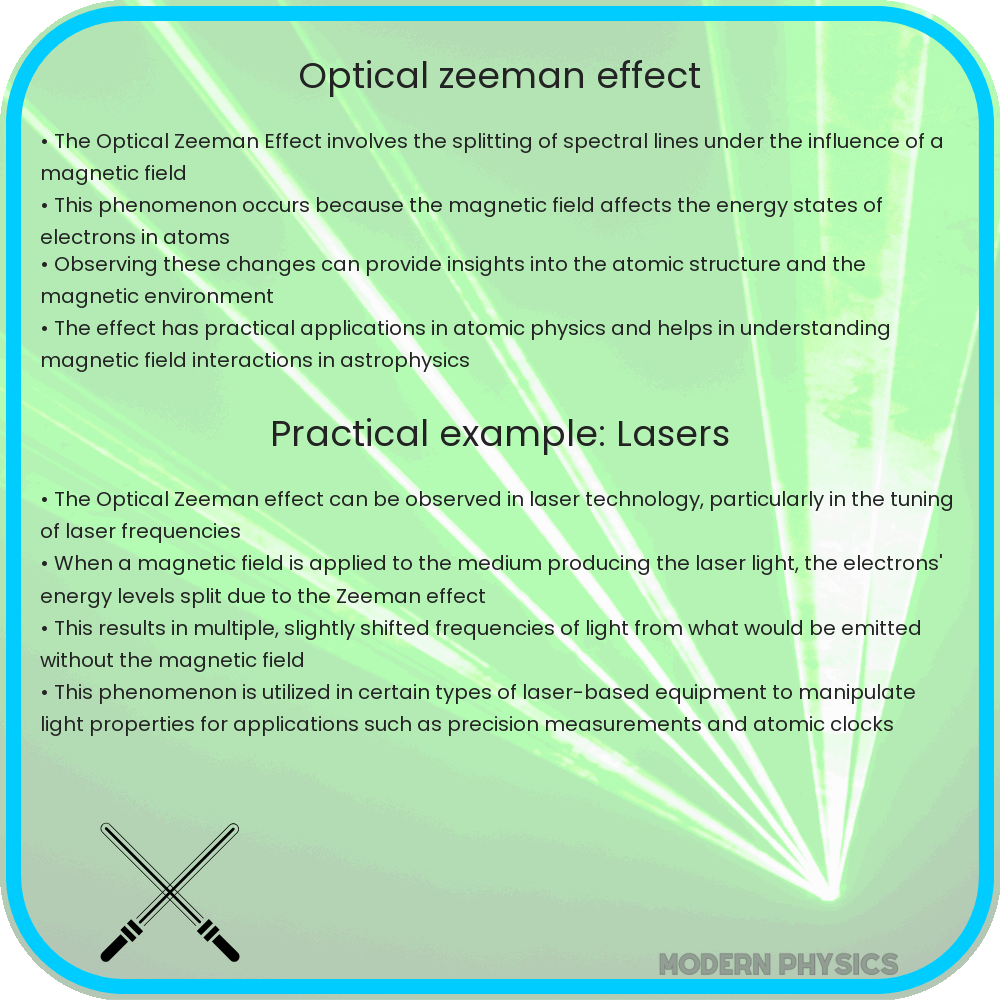Explore the Optical Zeeman Effect’s principles, applications in astronomy to quantum tech, and its role in unlocking the secrets of atomic physics.

Understanding the Optical Zeeman Effect
The Optical Zeeman Effect is a fascinating phenomenon in physics that reveals how light and magnetic fields interact at the atomic level. Discovered by Pieter Zeeman in 1896, this effect involves the splitting of spectral lines of atoms when they are exposed to a magnetic field. This discovery provided critical evidence for the quantized nature of energy levels in atoms and played a crucial role in the development of quantum mechanics.
Principle of the Optical Zeeman Effect
At its core, the Optical Zeeman Effect occurs due to the interaction between the magnetic field and the magnetic moment of electrons orbiting the nucleus of an atom. When an atom is placed within a magnetic field, the degeneracy of its energy states is lifted, causing the energy levels to split into sub-levels. This splitting alters the frequencies of the light emitted or absorbed by the atom, resulting in the appearance of additional lines in its spectral emissions or absorptions—a phenomenon known as the Zeeman splitting.
The degree of splitting depends on several factors, including the strength of the magnetic field and the characteristics of the atomic orbitals. The effect can be categorized into two types: the Normal Zeeman Effect, where the spectral lines split into three components (one unshifted and two symmetrically shifted lines), observable in transitions where the total spin of the electrons is zero; and the Anomalous Zeeman Effect, which involves more complex splitting patterns due to transitions involving electrons with non-zero total spin.
Applications of the Optical Zeeman Effect
- Astronomy: The Optical Zeeman Effect is a powerful tool in astrophysics, allowing scientists to measure the magnetic fields of stars and other celestial bodies by analyzing the splitting of their spectral lines.
- Atomic Clocks: Utilized in the precision tuning of atomic clocks, where the effect helps in the accurate measurement of atomic transition frequencies.
- Magnetic Field Measurement: The effect is used in laboratory settings to determine the strength and direction of magnetic fields at the atomic level.
The analysis and applications of the Optical Zeeman Effect have not only deepened our understanding of atomic physics but have also paved the way for numerous technological advances. Its implications in quantum mechanics and electromagnetic theory continue to be areas of active research and development.
Analysis Techniques and Challenges
Understanding the Optical Zeeman Effect requires sophisticated equipment and techniques. Spectroscopy, the study of the interaction between matter and electromagnetic radiation, is central to analyzing the Zeeman Effect. High-resolution spectrometers are used to observe the fine details of spectral line splitting. Furthermore, the interpretation of these results necessitates a deep understanding of quantum mechanics and electromagnetic theory. One of the challenges in the analysis is differentiating between the Normal and Anomalous Zeeman Effects, as the latter can exhibit complex patterns due to the involvement of electron spin.
Another challenge lies in the precise measurement of magnetic field strengths, especially in environments where the field varies on small scales, such as on the surface of stars or in the interstellar medium. Advanced imaging techniques and modeling are employed to map these magnetic fields accurately, utilizing the Zeeman Effect as a diagnostic tool.
Future Directions and Potential
The Optical Zeeman Effect continues to be a subject of research with potential applications extending into new realms. One area of interest is in quantum computing and information processing, where the manipulation of atomic states under magnetic fields could lead to advances in quantum bit (qubit) design and control. Additionally, the effect is being explored in the context of improving the sensitivity and resolution of spectroscopic instruments, which could revolutionize fields like chemical analysis and biomedical imaging.
Emerging technologies, such as nanofabrication and photonics, also stand to benefit from a deeper understanding of the Zeeman Effect. By controlling light-matter interactions at the nanoscale, scientists and engineers could develop more efficient sensors, lasers, and optical devices, all leveraging the principles of the Zeeman Effect.
Conclusion
The Optical Zeeman Effect is a cornerstone of modern physics, providing essential insights into the quantum nature of matter and the fundamental interactions between light and magnetic fields. Its discovery marked a pivotal moment in the history of science, influencing the development of quantum mechanics and expanding our capacity to observe and understand the universe. Today, the Zeeman Effect finds applications across a broad spectrum of scientific disciplines, from astrophysics to quantum technology, and continues to inspire research into the fundamental forces that shape our world. As technology advances, the exploration of the Zeeman Effect will undoubtedly unveil new phenomena and pave the way for future innovations.
